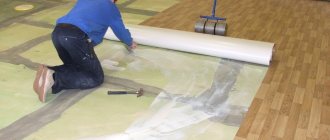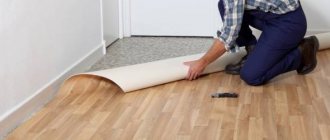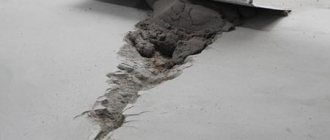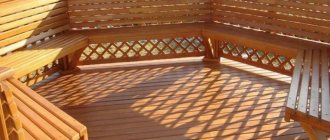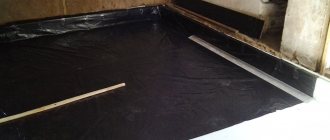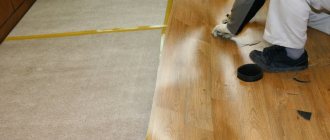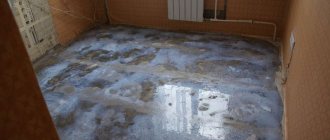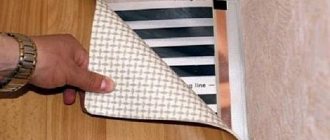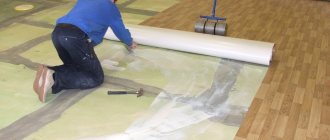Linoleum is perhaps the most common type of flooring, which combines high aesthetics and characteristics. In modern apartments this material is often installed as flooring. An abundance of different colors allows you to choose exactly what interests the home owner, so that you get reliable sound insulation of the floor from neighbors.
@Linoleum
Linoleum coating can be classified as a group of materials that can be used with almost any type of soundproofing substrate. In order to achieve effective soundproofing of the floor in an apartment under linoleum, you need to look at the quality of the material used. The effectiveness of sound protection depends on this.
Features of sound insulation under linoleum
To soundproof the floor, a special material is laid under the linoleum - a substrate. It not only dampens noise, but also has thermal insulation properties, and evens out minor unevenness in the base.
The soundproofing substrate dampens sounds, has thermal insulation properties, and evens out minor unevenness in the base.
Experts recommend laying a sound-absorbing layer under any linoleum, including floor coverings that have their own base. An additional layer will improve the noise and heat insulation characteristics of the floor.
Required Tools
The linoleum underlay can act as an additional soundproofing material, even if the screed has already been laid. When choosing a coating, you need to pay attention to the thickness. If linoleum has a natural base, then the substrate should be the same. Waterproofing is installed as additional protection. It eliminates the risk of material rotting.
From your inventory you will need:
- Construction hairdryer. Drying with a construction tool will ensure faster shrinkage of each layer.
- Stitching roller. Allows you to roll the surface so that it is level.
- Scissors. Needed in order to equally cut rolled raw materials.
- Solvent. This will be required if the surface needs to be degreased during repairs.
- The material itself is for sound insulation.
Let's consider the highest quality substrates for linoleum:
- TUPLEX. This building material is two-layer. Main components: polyethylene and foam granules. This substrate provides good hydro, steam, heat and sound insulation. Ease of installation will allow even beginners to cope with the task. The impact noise reduction index is 8 dB. Requires mandatory sealing of seams.
- Isonoise This option has a special composition. It is made from extruded polystyrene foam. Izoshum is sold in the form of rolls 3 mm thick or sheets with a thickness from 2.5 mm to 5 mm. The material will provide hydro, heat and sound insulation. Noise insulation index up to 15 dB.
- Izolon. It is made on the basis of elastic polyethylene foam and is produced in rolls, which ensures ease of installation. Izolon has all the standard properties, but the impact noise reduction index is much higher than that of its competitors. It is equal to 35 dB. It is better to purchase Isolon with a thickness of no more than 6 mm. The manufacturer provides a large selection.
- Cork. It is offered in a roll version and consists of pressed granules of natural origin. Provides not only sound insulation, but also protects the apartment from heat loss. High moisture resistance allows the use of cork in places with high humidity, with a thickness of no more than 3 mm. Noise insulation index - 18 dB.
- Vibration stack. Made from fiberglass. Fiberglass is a natural layer for flooring and is not susceptible to moisture or rotting. It is better to purchase products in rolls up to 4 mm. Noise insulation index - 29 dB.
We recommend: Review of sound insulation from Soundguard ecozvukizol
Types of sound insulation for the floor in an apartment under linoleum
For sound insulation in this case, the following materials are used:
- cork sheet or slabs;
- jute or flax fiber;
- combined variations of jute, linen, felt;
- foamed polyethylene with foil coating (penofol, isolon).
A cork backing, a fabric made of jute, linen, felt or a combination of them are natural, environmentally friendly materials. They allow air to pass through well, are resistant to mechanical stress, and have good noise and heat insulation properties. The only negative is the rather high price.
Foiled sound insulation made of polyethylene foam has low thermal conductivity and is affordable. This is a budget alternative to natural raw materials.
Modern materials for sound insulation
Having chosen a method of insulating the floor from noise, you will certainly find suitable materials, of which there are a lot on the market today, starting with fiberboard, chipboard, expanded clay screenings, fine-grained slag and ending with soundproofing boards of Russian and foreign production, made on the basis of basalt and glass fibers, mineral cotton wool. When choosing a material, you should take into account its composition, as well as physical properties - absorb sound, prevent its propagation or insulate.
Thus, plasterboard, concrete, brick—all hard materials—have sound-reflecting properties.
Materials with sound-absorbing properties are divided according to their degree of hardness. For example, those made from mineral wool based on vermiculite and volcanic perlite are also classified as solid.
Semi-rigid ones include those created on the basis of mineral wool, but with a cellular structure.
Finally, traditional soft insulators are felt, fiberglass and rolled mineral wool.
The degree of sound reflection from sound absorption is a parameter for choosing materials for sound insulation.
How to choose floor soundproofing in an apartment under linoleum
To choose the right underlay for such a floor, you need to take into account a set of parameters:
- type of base (concrete screed or wood);
- terms of Use;
- financial opportunities;
- personal preferences.
Important! You should purchase a layer for sound insulation under linoleum from trusted retail outlets and you should always check for a certificate for the product. This will allow you to buy reliable, durable and healthy building materials.
The soundproofing underlay is selected depending on the type of floor subfloor (concrete or wood), operating conditions, and personal preferences of the owner of the room
Soundproofing under linoleum on a wooden floor
For laying linoleum on wood floors, “breathable” natural materials are suitable, which freely allow air and moisture vapor to pass through. It is important that the substrate is sufficiently dense and rigid, because the top coating itself is soft.
A universal option for soundproofing under linoleum on a wooden floor is cork. Jute or linen fabric is also suitable, and to save a little money, you can buy a cheaper combined material made of wool, flax and jute.
Sound insulation under linoleum on concrete floor
When choosing sound insulation for linoleum on a concrete floor, you need to take into account the purpose of the room. A cork backing is ideal for a nursery, bedroom or living room; it effectively muffles noise and is a good insulator. An excellent option is a linen base or a combination of jute, felt and linen.
If you plan to install heavy furniture in the room, then it is better to choose jute or jute in combination with wool and linen. They do not wrinkle or sag; if you decide to move the closet or bed to another place, there will be no marks left on the floor.
Cork has one drawback - it is afraid of moisture. If you are planning natural sound insulation in the kitchen or hallway, then it is better to choose a linen or jute base. They do not rot, absorb sounds well and have low thermal conductivity.
In the case of budget repairs, it is advisable to use foil penofol or isolon. The main condition is to choose a material up to 3 mm thick, otherwise dents will appear on the floor covering.
Soundproof linoleum
Linoleum is one of the most common rolled materials used as flooring. The main advantage of the coating is its ease of installation, while it does not require special care and is quite functional, and the variety of colors and patterns allows you to choose the coating to suit any interior design.
@Linoleum
The material with the bottom layer has good sound insulation characteristics and low thermal conductivity. Linoleum is truly a universal type of coating. It can be used in residential and industrial premises due to its high degree of protection against abrasion and mechanical damage. Also, thanks to its antibacterial properties, sound insulation under linoleum is ideal for a bedroom or children's room. The product will not only make the floor beautiful, but will not harm the household.
Many people think that linoleum is a modern version of flooring, but it was patented back in 1863, but such a coating was used two centuries earlier.
Advice from professionals
Before laying the substrate, you need to properly prepare the base. The floor must be level, durable and resistant to deformation.
Attention! The foil sound insulator is placed with the foil on top. This is done so that the heat is reflected into the room.
When using foil soundproofing backing, you need to lay it with the shiny layer on top
How to make soundproofing of a floor with your own hands
When linoleum is selected, you need to take care of additional sound insulation. It is laid before laying the main floor covering. You can combine several layers of protection, for example:
- floating screed;
- concrete floor;
- dry screed;
- wooden prefabricated floor.
Any of these positions fits into three stages:
- The rough foundation is in the form of a reinforced concrete slab or a waterproofed earthen surface remains.
- Laying the insulating layer. The craftsmen call it “spacer” and the main provision of sound insulation upon completion of the work falls on his shoulders.
- Performing a floating screed. It is important that this finishing layer dries well.
During work, related equipment and additional building materials are prepared. To attach the baseboard you will need a screwdriver and self-tapping screws. The twist is carried out to the wall or floor. To avoid problems or force majeure situations, it is worth studying the basic rules when screeding:
- To prevent deformation of the screed, protective films are used.
- It is important to observe the temperature regime. Do not open windows to prevent debris from entering the room. If the building material is not at room temperature, it should be brought indoors. Otherwise, deformation will occur. Also, we must not forget about the dryness in the room. To quickly dry the room, heat guns are used. When laying soundproofing for the floor in an apartment under linoleum, a gap is maintained between the walls and the screed.
- The gaps are filled with a damping substance.
- When purchasing, it is important to take into account the noise insulation indicators that the manufacturer promises. They are indicated on product packaging.
Chipboard and plywood
They are usually used where it is necessary to level the concrete base, but it is not possible to do this with a screed or “wet” work is undesirable.
Therefore, usually a roll backing is also used on top of the wooden base. This method should not be used in living rooms; it is more suitable for practical premises. In addition, the heat and sound insulation properties of such a substrate are low.
The advantages of wood materials are:
- complete leveling of base irregularities;
- hardness of the coating, ensuring the integrity of linoleum for a long time;
- environmental friendliness;
- affordable price.
The disadvantages include:
- poor heat and sound insulating properties;
- the need to use additional softening materials;
- low moisture resistance of wood.
Fiberglass
In fact, fiberglass is a noise-insulating material that has good elasticity and strength.
That is why it is sometimes used as a substrate. It has a very small thickness, so it is used in those rooms where the concrete base is quite flat, but increased noise insulation qualities are required.
Its advantages are:
- high acoustic characteristics;
- naturalness and environmental friendliness;
- resistance to deformation;
- Possibility of laying directly on concrete.
Flaws:
- impossibility of use due to poor quality;
- probability of deformation under high mechanical loads.
How to determine the thickness of the material
The peculiarity of the installation of various products lies in the requirement for the base. For all types of materials, the room must be kept clean and dry when laying. It is necessary to empty the room of furniture and dismantle the baseboards.
The wooden base should be treated with a primer with an antiseptic; visible damage to the boards and seams should be repaired with wood putty. Then the selected type of substrate is laid. A roll lining made of natural raw materials is fixed with the staples of a construction stapler.
If you decide to lay sheets of chipboard, OSB or plywood, you need to calculate the required material. Then the frame is assembled. The joists are attached to the floor with screws and self-tapping screws. The slabs are laid so that the joints are staggered. The sheets are screwed to the frame with self-tapping screws.
Installation of hardboard fiberboard is carried out using wood screws or nails without installing a frame.
Waterproofing must be laid on the concrete screed (usually polyethylene is used) when there is an unheated basement below the room. Then the rolled cork backing is rolled out, the strips are fixed together with construction tape
To prevent damage to the cork, installation and subsequent installation of linoleum is carried out carefully and with care
The concrete base is leveled with a cement screed or self-leveling floor (with minor differences in height). Before applying the sand-cement mortar, the surface is treated with a primer. How long the screed takes to dry depends on the ambient temperature and humidity; in warm weather, you need to ventilate the room more often. The underlay should be laid after the floor has completely dried.
Penofol is spread with the foil facing up, the joints between the rows are sealed with foil tape.
Installing a rod-type infrared floor is too labor-intensive to install, so it is easier to choose a film version of a heated floor. You should not place thermal film under furniture, since infrared radiation heats surrounding objects. The thermo-reflective bedding is laid out and secured with tape. Then the IR film is spread out, connected into a circuit with clips, and the wiring is connected to the thermostat and temperature sensor. Floors can be grounded.
IMPORTANT: The underlay should be used regardless of whether the linoleum has a base or not. It not only increases heat and sound insulation and levels out minor unevenness in the base
But it also acts as protection against contact with the base.
In concrete foundations, after the screed has fully matured, moisture remains. Its emission varies depending on air humidity, temperature and even atmospheric pressure. Linoleum, even on a special basis, will take on this destructive effect. To minimize it, the substrate protrudes. But when using substrates made of natural material, it is necessary to organize waterproofing using a thick polyethylene film.
The passage of thermal and sound waves through dense materials is described in detail in the Debye model. To reduce heat loss and increase sound insulation, it is necessary to create a “layer cake” on the floor. In this case, the substrate helps out.
READ MORE: How to lay linoleum on a wooden floor correctly Video
Please note that when organizing sound insulation, a very curious phenomenon occurs. If it is organized incorrectly, you can achieve an effect where your neighbors can hear you, but you can’t.
In fact, you seem to be comfortable in silence, but the awareness of the fact that they hear you will not allow you to calm down. It is the substrate that eliminates such an incident.
On a wooden base, all of the above factors appear to a lesser extent, but they are present. They are also leveled using a substrate.
Ideally, these parameters should match.
Additional screed or subfloor on joists
Even when using heterogeneous linoleum with an additional substrate, the soundproofing properties of the floor can be enhanced during the manufacture of the screed or rough base on the joists.
Sound insulation between joists
A subfloor on joists is a quick and inexpensive way to level and insulate the base. After preparing the base, performing a vapor barrier and attaching the logs, roll or slab soundproofing material is laid between the bars. They use materials from basalt mineral wool (“Rockwool” or “Isover”) or modern aragonite texaund.
Soundproofing a wooden floor using joists
Pieces of cotton wool are cut out with a margin, tightly mounted between the bars. After laying the insulation under the plywood, additionally roll sound insulation (“Shumostop”, “Isoshum”) is laid.
After laying plywood or OSB, multilayer linoleum is rolled out.
Soundproofing a concrete floor
When installing a new screed (dry, semi-dry or wet), soundproofing boards are laid as the first layer. ISOPLAAT slabs are considered the best option. With a small thickness (2.5 cm), the fibrous material provides noise absorption up to 26 dB.
The screed is carried out using standard technology; the first layer is soundproofing material. The substrate is covered with roofing felt, polyethylene, and a screed is applied.
After the screed has dried, additionally lay roll sound insulation or use multi-layer linoleum.
Felt backings
Felt is used extremely rarely due to the lack of a moisture-protective layer and poor ventilation, which leads to rotting and loss of basic properties. However, the fabric shows excellent results when paired with insulating layers. It has sufficient rigidity and an advantageous combination of sound absorption and thermal insulation properties.
Types of insulation materials
It is wrong to say that there are good and bad insulation materials. You can select and install insulation only in relation to specific conditions.
It is no coincidence that this material has gained such wide popularity. The following points contributed to this:
- Affordable prices for most consumers;
- Availability of high performance characteristics;
- Presentable external data.
A nice bonus is that it is very easy to install. The base consists of elastic polyvinyl chloride. There is a homogeneous type of material, the thickness of which does not exceed 2 mm, and a heterogeneous type (with several layers). Its thickness can reach up to 7 mm. Depending on its purpose, linoleum can be commercial, semi-commercial and household.
The most durable product is the commercial type. Usually it is laid on the floors of public premises and industrial areas. In this review, the emphasis is placed on the household area. In principle, if the floor is flat, and the linoleum itself already has insulation, then the flooring can be carried out without the use of a substrate.
When buying insulation for a cold floor under linoleum, you should not blindly believe the advertising. An advertisement that claims that the material is made from highly environmentally friendly components sounds simply ridiculous, since it is already initially a synthetic product.
Substrates can exist in the following types:
The material for its manufacture is cork, or rather its bark. It is available in different thicknesses and different levels of rigidity. If installation is carried out on a concrete base, then it is necessary to think about waterproofing. You can use simple polyethylene for this. Cork does not tolerate excess moisture. If we consider such an indicator as thermal insulation, then such a substrate leaves no chance for its competitors.
Laying cork on the floor
To lay it down you need a rigid base. Otherwise, even the legs of the chair underneath will leave marks. Cork backing is more applicable in the case of laminate flooring. If linoleum is laid, then due to its high cost there is simply no point in using it.
Natural, environmentally friendly and cheap product. It can be well imagined if you remember ordinary burlap. The fact is that their basis is the same. Such a substrate does not care about moisture and fire. It will not cause allergic reactions. But its sound insulation leaves much to be desired. Due to the fact that this type of substrate is supplied from abroad, it is not cheap. A similar material is applicable to wooden floors. A good alternative would be to use a linen backing. The effect will be the same, but the cost will be lower.
Its thermal insulation characteristics can completely compete with jute fabric. But it will cost the consumer much less. Advertising in the case of linen backing is also clearly disingenuous. Although the canvas itself is natural, its impregnation has a clear synthetic base. But they impregnate it so that it repels moisture.
Polystyrene and polyurethane
Materials made from polyurethane foam or polystyrene boards are widely used. They are able to block sounds from neighbors, are not subject to rotting and tolerate a humid atmosphere well. The main purpose of this group of substrates is not sound insulation at all, but heat preservation. Therefore, by choosing this type of coating you get both noise reduction and insulation. However, the effectiveness of this type of insulator will be lower than that of others. However, the low price significantly influenced their popularity.
